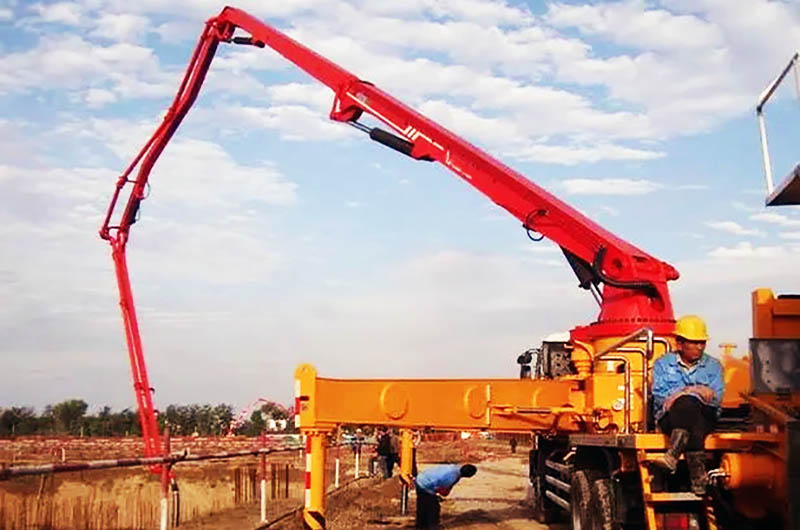Concrete pumping technologies are essential elements that contribute to the success of large and complex construction projects. With the increasing scale and diversity of projects, concrete operations require advanced techniques to ensure the highest standards of quality and efficiency. In this article, we will explore the latest concrete pumping technologies and how they can be used to enhance project performance and achieve desired results.
What Are Concrete Pumping Technologies?
Concrete pumping technologies involve using specialized equipment to transport concrete from the mixing site to the pouring site. These techniques vary in complexity and efficiency, and the choice of the appropriate technique depends on several factors, including project size, concrete type, and the distance the concrete needs to travel.
Types of Concrete Pumping Technologies
- Static Pumping Systems
Static pumping systems are among the most common methods used in large projects. These systems use fixed pumps installed at a specific location and pump concrete through pipes extending to various areas of the construction site. These systems provide continuous flow and allow precise control over pumping speed and the amount of concrete delivered.
- Mobile Pumping Systems
Mobile systems are characterized by their flexibility and ease of transportation, with concrete pumps mounted on trucks or trailers that can be easily moved between different locations on the construction site. These systems are typically used for projects requiring short-distance concrete pumping but need repetitive pumping operations in multiple areas.
- Air-Driven Pumping Systems
Air-driven systems are advanced solutions that use air pressure to transport concrete through air pipelines. This technology provides high control over concrete flow and allows precise pouring, making it ideal for projects requiring high precision in concrete distribution.
- Underwater Pumping Systems
In projects that require concrete pouring underwater, underwater pumping systems ensure that pumping continues under challenging conditions. Equipment resistant to water and pressure is used to ensure that the quality of the concrete is not affected by marine conditions.
Benefits of Using Advanced Concrete Pumping Technologies
- Improved Concrete Quality
Modern pumping technologies help ensure uniform distribution of concrete across all parts of the construction, enhancing the final product’s quality. The chances of defects such as voids or gaps within the concrete are reduced, leading to better durability and sustainability of the project.
- Increased Time Efficiency
Advanced pumping technologies allow for faster execution of pouring operations, reducing the overall time required to complete the project. By improving concrete flow and minimizing the time spent on transportation, project phases can be expedited significantly.
- Cost Reduction
By improving operational efficiency, advanced concrete pumping technologies can help reduce overall project costs. Reducing the time and resources needed for pumping operations lowers labor and equipment costs.
- Enhanced Safety
Safety is a critical element in construction projects, and modern pumping technologies improve safety by reducing the need for manual intervention and minimizing risks associated with traditional transportation methods. This enhances the work environment and reduces accidents.
Challenges of Using Concrete Pumping Technologies
Despite the significant benefits, there are some challenges associated with using advanced concrete pumping technologies. These challenges include:
- Requires Regular Maintenance
Advanced equipment requires regular maintenance to ensure its efficiency. Technical teams need to inspect the equipment regularly and ensure its readiness to work to avoid issues that may affect the project’s progress.
- Investment Cost
Advanced technologies may require a higher investment in terms of purchase or rental and maintenance. However, this investment can be justified by the substantial benefits they provide.
- Training and Operation
Operating advanced equipment requires specialized training. Some systems demand advanced technical knowledge to ensure optimal results.
Applications of Concrete Pumping Technologies in Large-Scale Construction Projects
Concrete pumping technologies are widely used in various large-scale projects such as residential towers, commercial projects, and bridges. These technologies play a significant role in enhancing construction efficiency and quality, making them an ideal choice for projects requiring high precision and exceptional results.
Residential Towers
In residential tower projects, pumping technologies help ensure uniform concrete distribution across different floors. These technologies facilitate balancing concrete quality and project speed, achieving construction goals efficiently.
Commercial Projects
In commercial projects, pumping technologies expedite the construction process and ensure quality standards are met. These technologies help reduce the time spent on concrete pouring, enabling faster and more efficient commercial project execution.
Bridges
For bridge construction, pumping technologies ensure that concrete reaches difficult-to-access areas and is distributed evenly. These technologies are crucial for achieving the stability and durability required for bridges.
The Bright Future of Concrete Pumping Technologies
With technological advancements, concrete pumping technologies are expected to continue evolving and achieving further improvements. Future trends include enhancing energy efficiency, developing smarter systems, and integrating digital technologies into pumping operations.
In conclusion, advanced concrete pumping technologies significantly enhance the quality and efficiency of large-scale construction projects. By understanding how these technologies work and applying them correctly, exceptional results can be achieved in various projects, ensuring their success.

